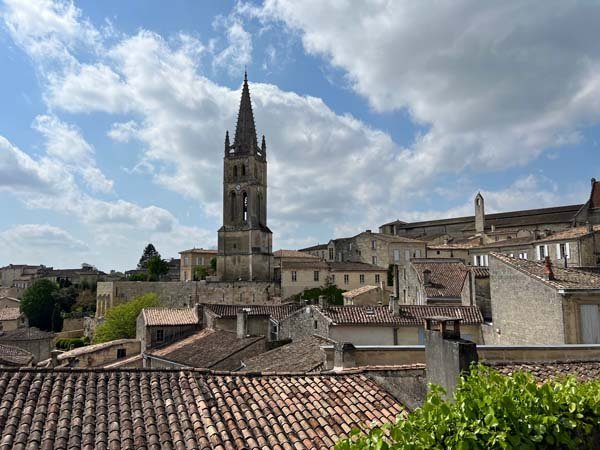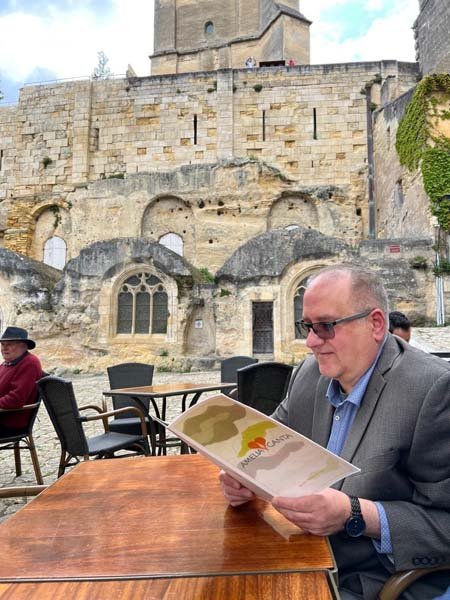The State of Bordeaux
Travelling to the 2021 En Primeur tastings is a study in contrasts—while the vintage we’re about to taste (2021) is largely defined by its multitude of challenges, the past half-decade is full of brilliant wines that speak to the precision and refinement of modern Bordeaux. While many are quick to celebrate the trilogy of 2018/2019/2020, they all seem to reach for 2016 as the gold standard, while 2015 isn’t far behind either. Even if the 2017s don’t hit those same heights, they are charming wines that are full of character and depth. So, before we even delve into the 2021s, it is worth looking back and putting this run in perspective.
K&L Hollywood Bordeaux Specialist Jaques Moreira enjoying Bordeaux life al fresco.
Rarely will you find a string of vintages with such consistency and quality, but it’s not just a matter of luck and fortune. The exacting approach that winemakers work with these days is an amazing feat—from individually fermented plots to a deep understanding of viticulture and terroir. While grand châteaux used to be the name of the game, now wineries are built from the vineyard up, with a mind for the intricacies that come with each row of vines or slightly differing soil types. There has also been a big return to classicism, producing less extracted and more balanced wines, although, with warm vintages being the par, there’s still no lack of ripeness.
When considering how much great wine is available from Bordeaux, perhaps revisiting the 2016s is the best place to start. Heralded from its early days, it is clearly the measuring stick for this era of Bordeaux. Whether you are looking for value, long-term collectibles, or anything in between, it’s hard to miss when looking at the ‘16s. But it has come into greater perspective with each passing year that both the qualities modern wine lovers look for (structure, extraction, accessibility) and those that fans of a more classic style argue for (lower alcohol, balanced acidity, seamless tannin) can be found in this vintage. Those who have these 2016s in their cellar will be rewarded for years to come, but they’re also relatively available for those looking to backfill.
The prior year, 2015, has a ton to offer, but with a few caveats. The northern Médoc struggled—you might often find better St-Estephes from 2014 (and more affordable, at that). But the quality of 2015 overall is not to be overlooked. Margaux was especially successful; the Right Bank served up delicious and accessible wines across the board; and Pessac turned out an incredibly strong stable of superlative examples. It also is one of the better years from Sauternes since the sneakily good 2011s. These wines also often have sweet-spot price points—they were a terrific value En Primeur, and the wines have continued to provide upside ever since.
The trio of 2018, 2019, and 2020 are going to be endlessly intriguing to follow for the years to come. The ‘18s are a bit of a miracle vintage—the weather was terrible until early July, but the balance of the season was nearly perfect. For estates who didn’t loose fruit to early season frost and mildew, the end result was a mix of ripe, attractive, and easy-to-enjoy wines, the best of which have the capacity to rival all-timers from some especially diligent estates. 2019 was defined by the En Primeur campaign itself—pandemic-inspired discounts made some wines more affordable than they’ve been in decades. The wines are incredibly fresh, but often express quintessential characteristics of the respective properties. And while 2020s are still a while out, there’s a good chance that some of the best will be the winners of the trio in the long run.
It is also very fascinating to see how these wines are being received and the shifting landscape in the most prominent voices among wine writers. Many industry insiders are quick to celebrate William Kelley rising to the ranks of the Wine Advocate’s Bordeaux reviewer, while Jane Anson setting off on her own with Inside Bordeaux adds another seasoned perspective to the mix. It might take a long time to recalibrate to these new and influential palates, but they are also two incredibly insightful and talented writers. In the meantime, we’ll be here to try to reveal the many wonders of Bordeaux through diligent tastings and notes, and will be endlessly searching for that next special bottle that has a story to tell.
And that brings us to the 2021s. This will be a vintage where having a trusted perspective will go a long way—one of the many reasons our team is here this week, driving back and forth across the Gironde to taste as much as possible. Our first stop, as usual, is with the team at Vignobles K, this time at their (relatively) new property Bellefont-Belcier. While wines like Haut-Brisson (production down two-thirds this year) and Tour Saint Christophe often take center stage, the flagship Bellefont-Belcier is a stunner in 2021, showing a remarkable level of aromatics, complexity, and persistence. It is just the faintest hint of what the 2021 Bordeaux vintage has to offer—we’ll really get into the thick of it in St-Emilion and Pomerol tomorrow. But until then, it is clear to see why Bordeaux is a region that has more compelling wines than ever.
- Ryan Moses, Bordeaux Specialist/Marketing and Retail Analytics Manager



